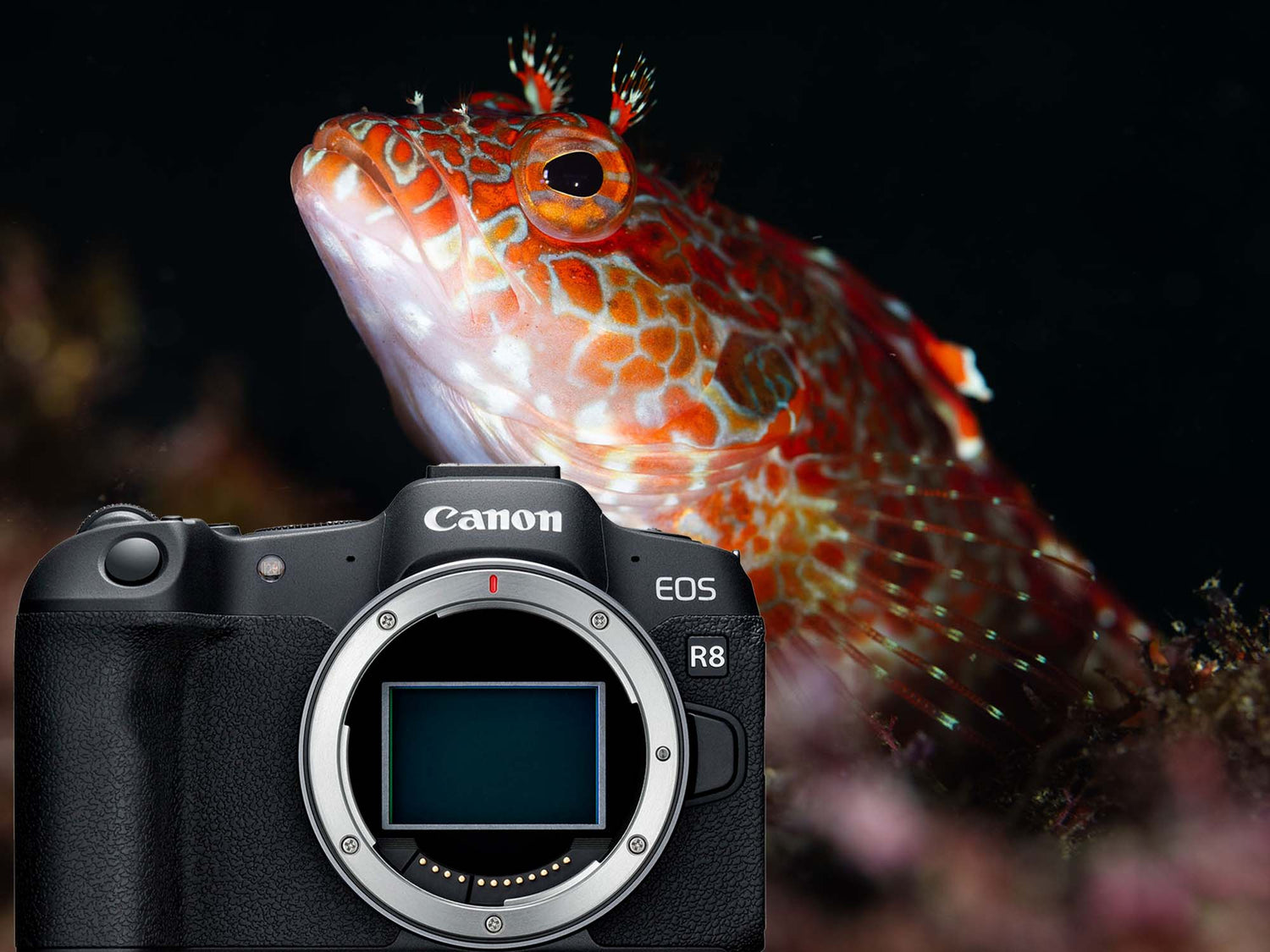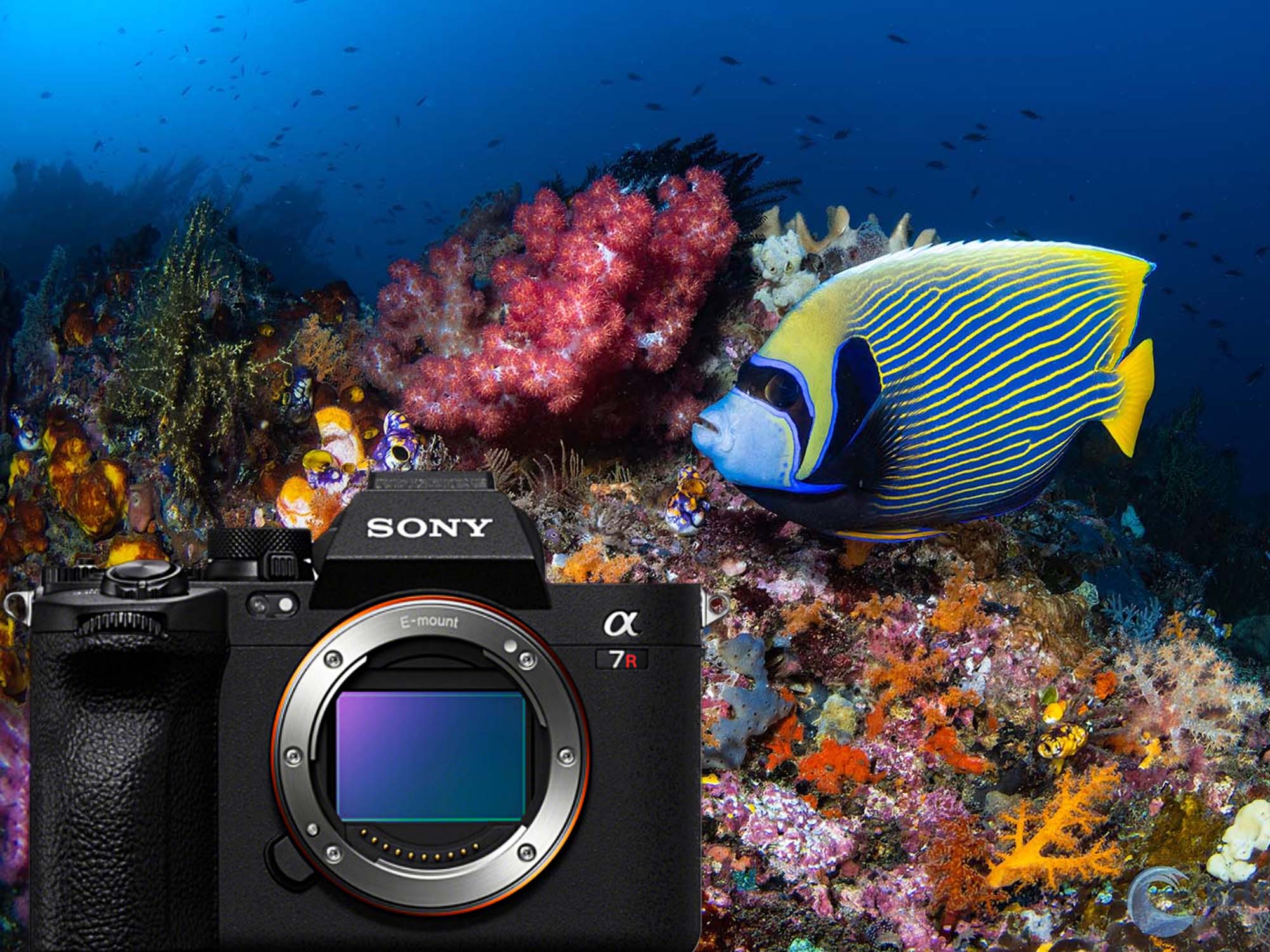By Jean Rydberg
All Images © 2023 Nirupam Nigam
There was a time when those who were most "serious" about underwater photography could be spotted by their imposing underwater housings. Camera manufacturers used to save their best technology for their top-of-the-line flagship cameras and dumb it down for the rest of us. Not anymore.
The Canon R8 is a revolutionary advancement for underwater shooters. It's enjoyable to shoot and is capable of producing the same results we fell in love with from the Canon EOS R6 II.
1/200 • f/13 • ISO 100 • RF100mm F2.8 L MACRO IS USM © Nirupam Nigam
The Underwater Advantage
The exciting part is the size. The Canon R8 is significantly smaller than cameras like the R5 and R6 II. We have optimized the housing for the Canon EOS R8 to support all of the camera's capabilities in a system that's half the size and weight of a typical Canon EOS R6 II housing. As a result the underwater housing for the Canon EOS R8 is significantly easier to travel with and easier to swim with underwater.
It's clear that the Canon EOS R8 is a game changer for entry-level full frame shooters. There has never been a time when you could squeeze this much value out of a camera....and a compact camera at that. - Nirupam Nigam, Bluewater Photo
The ergonomics are intuitive and we find Canon's controls and menus to be among the most straightforward. The 200DLM/C Underwater Housing brings shutter and back button focus to your fingertips.
Ikelite underwater housings are designed and manufactured in the USA. Want a quick answer? Shoot us an email or give us a call. Our team of divers and photographers are in the office every week day answering customer questions about gear selection, use, maintenance, camera settings, and photo advice.

1/40 • f/11 • ISO 400 • EF8-15mm f/4L FISHEYE USM © Nirupam Nigam
Why Shoot Full Frame Underwater
The Canon EOS R8 is a 24 megapixel camera with a full frame sensor. That begs the question of how does it compare to other 24 megapixel APS-C sensor cameras. There are a couple of advantages to shooting full frame. A full frame sensor is significantly larger than the APS-C sensor - it’s actually 60% larger. This allows it to gather more light information per pixel. Your images will generally have less graininess, especially at higher ISO settings. It also gives them better dynamic range- that is, capturing very light and very dark elements in the same frame with better tonal gradations in between. For this reason, frame cameras do better in low light situations. Underwater we tend to be chronically low light- so the more light we can capture the better.
The second reason is angle of coverage. This is particularly important if you want to shoot wide angle, a full frame camera will maximize your field of view. The crop sensor APS-C cameras will do just what their designations suggest, they give you a cropped view of the scene. This is actually helpful for macro but can be limiting in wide angle photography.

1/100 • f/13 • ISO 200 • RF14-35mm F4 L IS USM © Nirupam Nigam
Autofocus
Canon's AI-enhanced autofocus system is among the best out there right now, and they crammed all of the advancements into the R8. We find that Canon quickly and accurately tracks focus even in low-light, low-contrast environments. Canon doesn't advertise "fish eye detection" in their cameras, but we can report that the camera is definitely capable and it's game changing.
It's difficult to appreciate how good the latest AF systems are until you've used them. An AF system that dependably focuses on eyes near the AF point you've selected means that you don't have to give any thought at all to focus and can instead concentrate on light, exposure and communicating with your subject. Sure, you've lived without it up until now, but I can assure you that you won't want to go back. - Richard Butler, DPReview.com

1/160 • f/11 • ISO 200 • RF100mm F2.8 L MACRO IS USM © Nirupam Nigam
Lens Selection
Quality optics are essential for making the most of any mirrorless camera. We find Canon RF and RF-S lenses provide fast, smooth autofocus, and sharp results. Most popular EF lenses also work well using the Canon EF-to-RF adapter.
The DLM port mount is a smaller version of the Dry Lock port mount found on our 200DL underwater housings. This makes it even lighter to travel with and more compact in the water. Zoom gears are affordable and simple to install.
The port system is optimized to support a selection of preferred lenses from wide angle zoom and fisheye to macro. The largest and heaviest full frame lenses are incompatible with the DLM port mount.

1/80 • f/10 • ISO 1000 • EF8-15mm f/4L FISHEYE USM © Nirupam Nigam
Video Performance
For video shooters you get oversampled 4K at up to 60p using the full width of the sensor. There is an autofocus option to only focus on a detected subject which can reduce wandering from the feature of your frame. You're missing out on in body image stabilization (IBIS), but we haven't found that to be a problem when shooting with an image stabilized Canon IS lens. We still think this is the best option for full frame video in its price range.

1/160 • f/22 • ISO 320 • EF8-15mm f/4L FISHEYE USM © Nirupam Nigam
Security
Ikelite produces the only full featured, professional-grade underwater housings that allow you to clearly see the camera and o-ring seal after the housing is closed. Our low profile vacuum valve and pump allow you to quickly and easily test the system for leaks prior to entering the water.

1/100 • f/10 • ISO 640 • EF8-15mm f/4L FISHEYE USM © Nirupam Nigam
Strobe Support
The Ikelite flash bulkhead comes standard on the housing and is still the fastest and most reliable way to trigger strobes underwater. Electrical flash triggering has zero lag time and zero missed signals. Sync cords are available to attach either Ikelite strobes or strobes from INON, Sea&Sea, Retra, and others that support direct triggering.
Adding the DL5 DS Link TTL Converter allows the camera to accurately meter the scene and adjust strobe powers automatically. If you're shooting fast moving subjects without burst mode and TTL strobe exposure, then you're probably not getting the best shot possible.
The housing for the Canon R8 supports fiber optic triggering of external strobes by adding the optional Manual Fiber Optic Transmitter.

1/250 • f/8 • ISO 640 • RF14-35mm F4 L IS USM © Nirupam Nigam
Battery Life
One of the few drawbacks of a smaller-body camera is the smaller battery pack. But in practical use, we find that the Canon R8 can get us through most days of diving. Primary stills shooters will have it pretty easy. We recommend getting used to the camera's big, bright LCD screen and utilizing power save functions that allow it to sleep in between shot sequences.
If you're a primary video shooter you will want to travel with a spare battery pack or two (which is a good idea anyway) to ensure that you won't be stressed getting through a day of diving.

1/160 • f/10 • ISO 200 • RF100mm F2.8 L MACRO IS USM © Nirupam Nigam
Value
Price is one of the most stunning features of this camera at only $1499US (body only). This makes it the most affordable full frame camera on the market right now, at $300 less than the Sony a7C. Compared to the Sony a7C, the Canon R8 has 50% more autofocus points, nearly 2x the LCD screen resolution, and a faster flash sync speed.

1/80 • f/14 • ISO 400 • EF8-15mm f/4L FISHEYE USM © Nirupam Nigam
Conclusion
If you're looking for the best performance underwater without blowing your budget, then look no further than the Canon EOS R8. The underwater world has never before seen this caliber of camera in such a travel-friendly and easy-to-use underwater system.
Contact us today to build out the perfect rig for your next underwater adventure.
Read Nirupam Nigam's review of the Canon R8 on Underwater Photography Guide.

1/80 • f/20 • ISO 800 • EF8-15mm f/4L FISHEYE USM © Nirupam Nigam
 Jean Rydberg, daughter of Ike Brigham, became President & CEO of Ikelite in 2006. Prior to that, she wisely pursued a degree in Astronomy & Astrophysics to prepare herself for the challenges of running a technology-driven manufacturing business with global distribution. Jean fully embraces the need to travel outside of her hometown of Indianapolis to experience good diving. She believes that any camera is capable of amazing results in the right hands, and anyone can become a great photographer given the right advice. When she's not working she's spending time with her husband, cats, and two daughters.
Jean Rydberg, daughter of Ike Brigham, became President & CEO of Ikelite in 2006. Prior to that, she wisely pursued a degree in Astronomy & Astrophysics to prepare herself for the challenges of running a technology-driven manufacturing business with global distribution. Jean fully embraces the need to travel outside of her hometown of Indianapolis to experience good diving. She believes that any camera is capable of amazing results in the right hands, and anyone can become a great photographer given the right advice. When she's not working she's spending time with her husband, cats, and two daughters.
 Nirupam Nigam is a dedicated underwater photographer and fisheries scientist. While growing up in Los Angeles he fell in love with the ocean and pursued underwater photography in the local Channel Islands. He received degrees in Aquatic and Fisheries Science and General Biology, as well as a minor in Arctic Studies, at the University of Washington. Nirupam is the editor-in-chief of the Underwater Photography Guide and Bluewater Photo. He also works as a fisheries observer on boats in the Bering Sea and North Pacific. When he is not at sea, he is traveling with his fiancee and taking photos. Check out more of his photography at www.photosfromthesea.com!
Nirupam Nigam is a dedicated underwater photographer and fisheries scientist. While growing up in Los Angeles he fell in love with the ocean and pursued underwater photography in the local Channel Islands. He received degrees in Aquatic and Fisheries Science and General Biology, as well as a minor in Arctic Studies, at the University of Washington. Nirupam is the editor-in-chief of the Underwater Photography Guide and Bluewater Photo. He also works as a fisheries observer on boats in the Bering Sea and North Pacific. When he is not at sea, he is traveling with his fiancee and taking photos. Check out more of his photography at www.photosfromthesea.com!
Additional Reading
Canon RF 85mm f/2 IS STM Lens Underwater Photos and Review
Sea Turtle Portraits with DS230 Strobes
The Best Canon RF-Mount Lenses for DLM Underwater Housings
5 Situations Where You Need a Strobe Underwater [VIDEO]
My Must Have Underwater Housing Accessory // Cable Top Handle Grip [VIDEO]













![Sony a7R V Underwater Camera Review with Sample Footage [VIDEO]](http://www.ikelite.com/cdn/shop/articles/thumbnail_final.jpg?v=1678383061&width=960)
